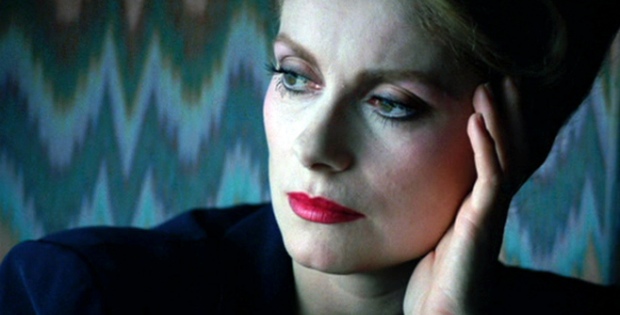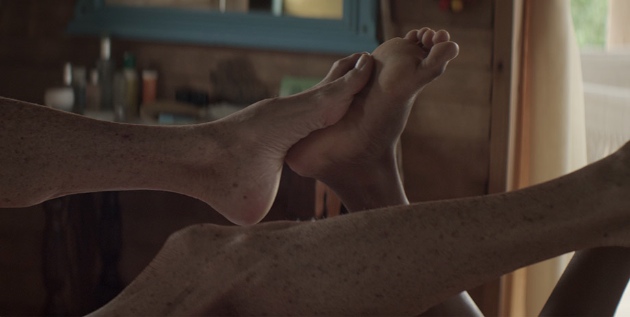
“For me there are two things: action and reflection. And I find that I’m more into action.”
– Catherine Deneuve
Female vampire mythology has long traded on erotics and unquenchable sexuality. From Theda Bara’s kohl-eyed, fangless silent movie-era “vamps,” to the bayou night-dwellers of True Blood, these creatures embody a lethal exceptionalism. Freed from the stifling constraints of time, of mortality, and of patriarchy’s rigid structure, the female vampire is a predatory affront to the expected feminine behaviours. Theoretically, a vampire is forever. Same goes for her abject, contemptible behaviour: victims seduced and murdered, blood consumed, on and on through millennia, or at least until a fortuitous meeting with a stake. What could be more threatening than a woman who kills to sustain her livelihood? (To say nothing of getting off on it, too.) The movies have made much use of this rich, yet somewhat cliché character trope. Tony Scott’s addition to the vampire canon, The Hunger (1983), however, repackages the ür-sexualized murderess with one of cinema’s most seemingly untouchable icons—Catherine Deneuve.
Casting Deneuve as anti-heroine Miriam Blaylock was a coup for Scott. Even the film’s original theatrical trailer proclaims “The timeless beauty of Catherine Deneuve” as a hook for buying a ticket to The Hunger. Scott thus became another director in as long and varied a mix as Luis Buñuel, Roman Polanski, Francois Truffaut, and Lars von Trier to use Deneuve’s patrician looks and frigid affect to lend roles of women-on-the-fringe a sick subversion. Buñuel did it most famously in Belle de Jour (1967) with Deneuve as a bourgeois S&M-obsessed housewife who finds sexual satisfaction in prostitution. Her filmography, however, puts forth a body of work that is richer, deeper, and darker than the media-generated narrative of Deneuve’s stardom, which has focused on a chic, aloof Parisian and her megawatt love affairs. Her looks have made her a favourite in the world of fashion; she posed for Vogue throughout the 1960s and was a spokeswoman for the Chanel No. 5 fragrance in the 1970s, and is still regularly photographed for magazines and ad campaigns. For the bicentennial of the French Revolution, the French government even modelled the “Marianne”—the personified symbol of liberty for the republic—on Deneuve’s likeness for limited edition banknotes and coins. The public image of Deneuve trades on surface, which is what, arguably, first transfixes her audience.
A critical and commercial flop upon release, The Hunger found cult status in its afterlife, in part due to the film’s hyperstylized mise-en-scène, serendipitous casting, and an opening scene with goth icon Peter Murphy, frontman of Bauhaus, performing the band’s 1979 single “Bela Lugosi’s Dead.” Scott’s follow-up film Top Gun (1986) thrust Tom Cruise and Val Kilmer into 1980s macho action stardom, and went on to become a Hollywood classic in the genre, putting Scott’s directorial career on the fast track. However, The Hunger, which rounded out its cast with an on-the-rise Susan Sarandon and a post-Let’s Dance pre-Labyrinth David Bowie, is remembered more for its camp eroticism and devilish ambiance. Bowie and Deneuve, as vampire lovers John and Miriam, are initially presented as equals in their partnership. The first glimpse of the pair shows Miriam’s predatory gaze, fragmented behind dark cat eye-sunglasses, a cigarette to her immaculately painted lips, zeroing in on potential victims. Together, they proposition a couple in a smoky, laser-lit nightclub for a supposed partner sex swap. After a few cocktails and tame foreplay, the swingers are eviscerated and discreetly disposed of in a furnace.
Soon after this opening kill, Miriam emerges as the dominant force as John, her partner of several centuries, is confronted with the vampire unthinkable: signs of aging. To John’s surprise, what Miriam promised when she turned John into a vampire—“forever and forever” youth, virility, and companionship—doesn’t pan out. A dreamy flashback recalls the two meeting in an eighteenth-century setting; another locates Miriam as an Egyptian sorceress, styled in the manner of Nefertiti. Her present 1980s New York iteration performs womanhood as a chilly, self-contained Hitchcock blonde-type with a penchant for piano, collecting ancient curios, and Yves Saint Laurent couture (the designer, a friend of Deneuve’s, supplied her wardrobe for the film). Miriam keeps scores of past lovers, not quite dead but in states of cadaver-like frailty, locked away in stacked coffins in the attic of her gothic luxe Upper East Side mansion; meanwhile, John is wrinkling by the hour, slated for the same fate.
Like any other of her kind, at Miriam’s core is the primal need to feed. The performative veneer she has worn throughout the ages is convincing because of her never-changing beauty, and she shields her monstrous appetites with an affect of well-executed elegance: the wealth, the indeterminable European accent, the sculpted designer suits and sunglasses. Even when she strikes—well-appointed in jewelry or black leather gloves and without pausing to put out her cigarette—the victim finds herself absorbed not in the killing, but in the shadow show of Miriam’s grace and sexuality. A kiss is expected, but what lands is a kill.

After seeing gerontologist Dr. Sarah Roberts (Sarandon) on a talk show discussing her work regarding unlocking human longevity, Miriam approaches Roberts at a book signing, already working her vampiric magic to seduce the doctor. Straightforward and no nonsense in t-shirts and business suits, Sarah is immediately bewitched by Miriam’s genteel demeanour. Sarah is not ignorant of Miriam’s refined charms; she remarks on how she pours Sarah a crystal glass of sherry, her studied piano performance, and when Sarah spills on herself, she bristles at borrowing anything as precious as Miriam’s clothing. At one point Sarah remarks to her husband, as a way to defend her burgeoning infatuation: “She’s a particular kind of woman. She’s European!” What could be seen as a harmless friend crush has deep roots in Miriam’s masterful manipulation. As Robert Latham comments in his book Consuming Youth: Vampires, Cyborgs, and the Culture of Youth Consumption, “Miriam’s sexual courtship of Sarah is a class seduction.”
The spilled wine on the t-shirt triggers the seduction, choreographed in a dramatic sex scene (gauzy drapes blow in the wind behind Miriam’s massive canopy bed; Léo Delibes’ swooning “Flower Duet” from his opera Lakmé is on the soundtrack). Mid-coitus, Miriam sucks the blood from Sarah’s arm. Sarah does the same in the moment, though we know Miriam’s insidious motives. But Miriam fails with Sarah. As Sarah spirals into her vampiric transition, getting “the hunger,” she commits suicide rather than become Miriam’s new companion in life and crime. The trick of the ending, which was restructured against the director’s wishes by parent company MGM who had its eyes on a sequel, sees Miriam besieged by a mutiny of her past lovers and also condemned to life in a box. Sarah is glimpsed living with a bevy of lovers in London, having usurped the power that Miriam once had. She ends up with the control, Miriam unceremoniously stripped of the surface trappings that enabled her agency. Sarah gains the frivolous details: the forever beauty, the forever sexuality. If Sarah remains the articulate do-gooder of her mortal character, we can’t be sure. Miriam gave her not just the freedom to decide otherwise, but desires that will never be satiated.
The parallels between actor and character in Deneuve and Miriam are perversely satisfying. Much like the unsuspecting characters that surround her, we too are seduced and then embroiled into narratives that repel and repulse. Cinematic archetypes imbue so-called beautiful women with certain functions: the femme fatale, the ingenue. Deneuve’s beauty is mutable, and she wields it accordingly. Polanski’s Repulsion (1965), his first English-language film, casts the 22-year-old as a paranoid, sex-averse spa worker who kills and dismembers a would-be suitor in her London apartment. Truffaut’s Mississippi Mermaid (1969) has her character, a con artist impersonating a man’s mail-order bride, steal, lie, and poison on a spree from Madagascar to Paris. Liza (1972) sees Deneuve as a woman having an affair with an artist on a Mediterranean island; she kills the artist’s sole companion, a dog, starts wearing his collar and licking, barking, and getting around on all-fours, assumes his identity in a sexually charged power play. Deneuve also recorded the real dog’s barking herself, blending the two roles in a surreal maneuver. In a 2008 interview with the director Arnaud Desplechin for Film Comment, she says:
Sometimes you have to accept that the image is more powerful than you.
I’ve been blind, dumb, amputated, and a killer, a vampire, a mother, a teen
mother, a lesbian, an alcoholic, and a thief. It’s unbelievable! I am shocked
when people talk about me and sum me up as: blonde, cold, and solemn.
But the trinity of Deneuve’s blondeness, coldness, and solemnness is surely what originally drew Scott to her for their combustive potential. The heat she carries in her performances, which smoulders and undulates beneath the surface, burrowing deep before rearing back up in an emotional wallop, is the real measure of Deneuve. Much like Miriam, Deneuve’s smoke screens seduce and divert. Appearances may be deceiving, but killer talent is forever.





